South Australia is the only Australian state that shares a border with the other four mainland states. South Australia is bordered on the north by the Northern Territory, on the northeast by Queensland, on the east by New South Wales and Victoria, and on the west by Western Australia. Adelaide is South Australia’s capital and largest city.
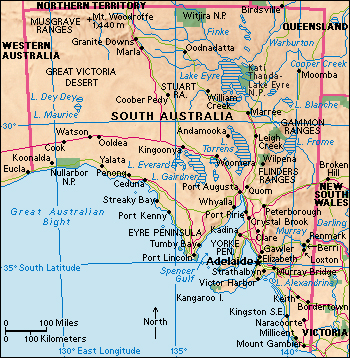
South Australia produces much of Australia’s barley, wheat, wine, and salt. Its iron-ore deposits are a major source of raw materials for the iron and steel industries of Australia.
South Australia calls itself the festival state. Two of its most important festivals are the Adelaide Festival of Arts, an international festival of performing, visual, and literary arts held every other year; and the Barossa Vintage Festival, an annual wine-tasting festival.
People
About three-quarters of the population of South Australia live in the Adelaide area. Most of the rest of the state’s people live in other cities and towns. Few people live in the state’s drier areas.
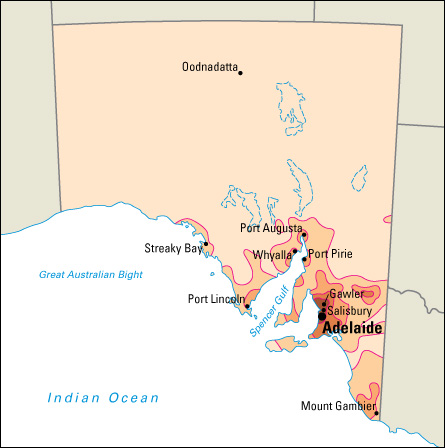

The original inhabitants of Australia were Aboriginal peoples. In some areas in South Australia, such as the Unincorporated West Coast, Aboriginal people make up more than one-third of the population. Overall, Aboriginal people account for about 2 percent of the state’s population.
About three-quarters of the current population of South Australia were born in Australia. Many of the people born overseas came from the United Kingdom. Other immigrant groups came from China, Germany, India, Italy, Malaysia, New Zealand, the Philippines, and Vietnam.
Schools.
Children in South Australia are required to attend school from the ages of 6 to 16. Those leaving school before age 17 must enroll in further education that may include career training or apprenticeships.
Education at the primary and secondary levels is available at government and nongovernment schools. About three-fifths of all students attend government schools. Most nongovernment schools are run by religious organizations. Many of them are Roman Catholic schools.
The state government sponsors the Open Access College, a long-distance education service for students who live in remote areas and cannot attend a school. The Open Access College uses two-way radio, correspondence, and the internet to communicate with the students. The school has several campuses in the state.
South Australia has several universities and other institutions of higher education, including the University of Adelaide, Flinders University, and the University of South Australia. The South Australian College of Advanced Education and the South Australian Institute of Technology merged in 1991 to form the University of South Australia.
Land and climate
Location and size.
South Australia lies in south-central Australia. Its south coast faces a bay called the Great Australian Bight and the Indian Ocean, which is known as the Southern Ocean in Australia. The state extends 820 miles (1,320 kilometers) from the Queensland border to its southern most point. South Australia is about 700 miles (1,130 kilometers) wide. Its coastline is 2,300 miles (3,700 kilometers) long.
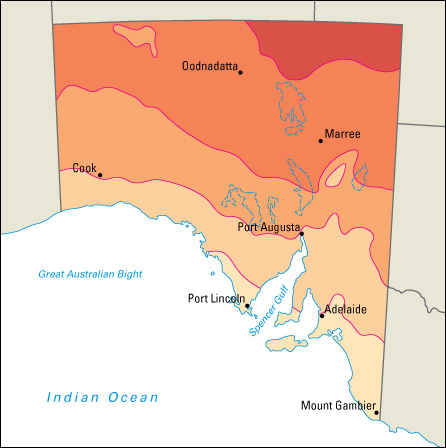
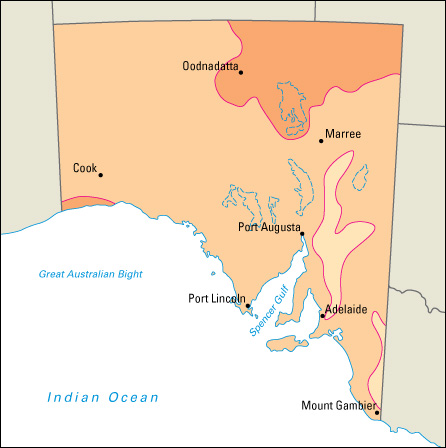
Land regions.
South Australia can be divided into five major geographical regions. They are (1) the Coastal Belt, (2) the Lower Murray Basin, (3) the Flinders Ranges, (4) the Nullarbor Plain, and (5) the Central Desert Area.
The Coastal Belt
consists of two parts. South of the Lower Murray Basin is the Southeast Plain. Mount Gambier, an extinct volcano, rises in the plain. Most of the Southeast Plain is level limestone. A series of parallel sand dunes block the natural drainage toward the sea. The state government has built an extensive drainage system to drain the swamps between the dunes. The coastal plains merge with the Ninety Mile Desert in the northeast.
North and west of the Lower Murray Basin, the Coastal Belt includes the Eyre Peninsula and Yorke Peninsula. Most of this area is flat and low, but it rises to 1,000 feet (305 meters) in the Gawler Ranges. Much of the Ranges make up a volcanic area that the government has designated as a national park.
The coastline area from Adelaide to Port Wakefield consists of muddy mangrove swamps, where the spreading roots of mangrove trees catch and hold soil. An almost continuous line of beaches stretches from the Outer Harbor of Port Adelaide, on the Lefevre Peninsula, to Brighton in the south. The thickly populated areas of Adelaide stand on plains built up by the rivers that flow westward from the Mount Lofty Ranges. The plain rises on the east and north into the foothills of the Mount Lofty Ranges.
The Lower Murray Basin
lies on both sides of the Murray River, which flows westward through South Australia and enters the sea at Encounter Bay on the edge of the Southern Ocean. A long, narrow stretch of wetlands called the Coorong is separated from the sea by an extensive system of sand dunes. To the south of the river lies the Murray Mallee, a dry limestone plain covered by red sandy soils and eucalyptus trees.
The Flinders Ranges
are part of a highland belt of ancient rocks that forms a backbone in South Australia. The northern ranges have cliffs and deep gorges and valleys. The highest point is St. Mary Peak (3,822 feet or 1,165 meters). See Flinders Ranges.
The Nullarbor Plain lies along the Great Australian Bight. This limestone plain has no rivers or trees, and no vegetation other than saltbush. The bight is a major sanctuary for southern right whales.
The Central Desert Area
is made up of two distinct parts—the Salt Lakes Region in the southeast and the Centre in the northwest. The Salt Lakes Region lies in a deep depression that curves round the Flinders Ranges. The vast Simpson Desert borders it in the north. The Salt Lakes Region includes areas around Lakes Eyre, Frome, Gairdner, and Torrens. These lakes only occasionally contain water. The rest of the time, they are dry beds of salt. Most of the Salt Lakes Region lies in the southwest corner of the Great Artesian Basin. See Salt lakes.
The Centre,
which lies in the extreme northwest of the state, is a flat, low area with almost no riverbeds. The eastern margins are covered by a series of tent hills (flat-topped hills). The remaining surface is covered by sand dunes or gibber (stone) plains. The Everard and Musgrave ranges rise above the surrounding area. The highest point is Mount Woodroffe (4,724 feet or 1,440 meters). The vegetation is sparse and consists of drought-resistant shrubs, chiefly bluebush and saltbush.
The desert areas in the extreme northeast of the state are covered by sandy parallel dunes and ridges of the Simpson Desert. The wind carries red dust from this area immense distances over Australia.
Lakes, rivers, and wells.
Lake Eyre and Lake Frome form the southern part of the Great Artesian Basin. Both of these lakes are nearly always dry and are known as salinas. There are four volcanic lakes—Blue, Crater, Leg of Mutton, and Valley—in the collapsed craters of Mount Gambier, an extinct volcano. There are also extensive lakes, such as Lake Bonney, along the course of the Murray, the main river in South Australia. The Murray flows through the state for about 400 miles (644 kilometers). Other, minor rivers include the Gawler, Light, Onkaparinga, Torrens, and Wakefield.
The state has tapped sources of artesian water from the Great Artesian Basin in the northeast of the state. Artesian water is underground water trapped under such great pressure that it gushes to the surface without being pumped. Wells also draw water from the Murray Basin and the Adelaide Plain Basin.
Climate.
The coastal areas of South Australia enjoy a Mediterranean type of climate—that is, they have hot, dry summers and cool winters. The average annual rainfall ranges from 25 inches (64 centimeters) on the coast to 6 inches (15 centimeters) inland. The average temperature in Adelaide is 72 °F (22 °C) in January and 52 °F (11 °C) in July. 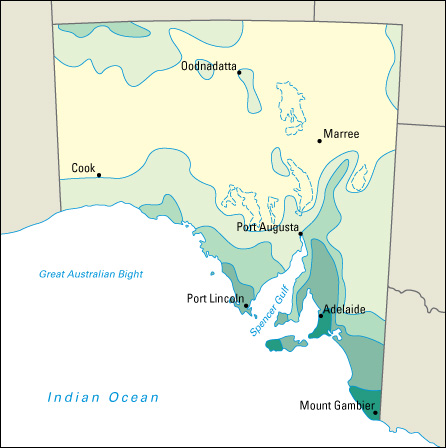
The Salt Lakes Region is the hottest and driest region of the state. It receives an average of only 6 inches (15 centimeters) of rain each year. The average temperature for Marree in January is 85 °F (29 °C). In July, it is 54 °F (12 °C).
Economy
Water supplies.
South Australia depends heavily on water from outside the state. The Murray River is vital to South Australia because local reservoirs cannot supply water to the expanding cities and towns and still keep enough in storage for dry years. An underground freshwater basin supplies water for the Eyre Peninsula. Underground water is also important in the southeast of the state. The Adelaide metropolitan area has a number of reservoirs. Major reservoirs also lie in the Mount Lofty Ranges and the lower Flinders Ranges.
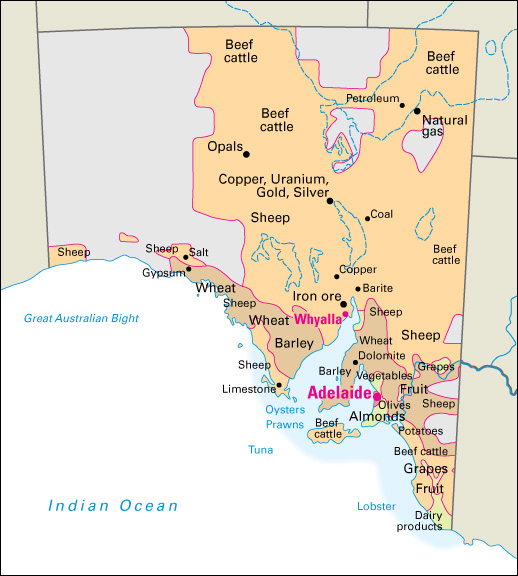
The high amount of salt in the soil and water is becoming a problem in South Australia, as it is in some other Australian states. Irrigated land is becoming polluted with salt because salty underground water rises close to the land surface. Runoff from this land is spreading the salt through rivers and other waterways. As a result, substantial areas of land are no longer suitable for agriculture.
Mining
is an important industry in South Australia, but the mining industry employs only about 1 percent of the state’s work force. Oil and gas together account for much of the value of minerals produced each year in South Australia. The largest onshore petroleum and natural gas development in Australia is at Cooper Basin in the far northeast of the state. The large Moomba natural gas plant processes gas from the Cooper Basin. Pipelines carry gas from the Moomba plant to Sydney and Adelaide. Another pipeline carries oil and gas to Port Bonython for export. Natural gas is produced at Katnook, in the Otway Basin, and is used to supply the southeast of the state. Queensland sends natural gas to South Australia by pipeline.
Copper, gold, silver, and uranium are mined at the Olympic Dam site at Roxby Downs and several other sites in South Australia. Production of these minerals expanded considerably during the late 1990’s and early 2000’s.
South Australia has extensive deposits of coal. But most of the coal is of poor quality or is buried too deep to be mined profitably. The only operating coal mine is at Leigh Creek, in the northern part of the state. The mine supplies coal for electric power generation at Port Augusta. Iron ore is mined in the south-central part of the state to supply steelworks at Whyalla.
South Australia supplies much of the world’s precious opals. The largest opal-mining center is at Coober Pedy. There are also mines at Andamooka and Lambina. Most of South Australia’s opals are exported. The state is also the major Australian producer of barite, a heavy mineral used in the oil well drilling industry. Large reserves of gypsum are mined at Blanchetown, Cooke Plains, and Lake MacDonnell. South Australia is a major salt producer. The state’s other mineral products include dolomite, limestone, and marble.
Manufacturing.
The production of motor vehicles and food products, especially meat and wine, are the largest manufacturing activities in South Australia. South Australia is the country’s leading wine-producing state. Large wineries are in the Barossa Valley and the Riverland, an area along both sides of the Murray River.
Other important manufactured goods include chemicals, fabricated metal products, iron and steel, and machinery. There is a strong high-technology defense industry based in Adelaide. Whyalla ranks as one of Australia’s leading steel centers. One of the world’s largest lead smelters is at Port Pirie.
Fishing.
The fishing industry uses almost the entire coastline of South Australia for commercial fishing. Leading fishing catches include abalones, crabs, garfish, prawns, rock lobster, sardines, snapper, squid, and whiting. Aquaculture (fish farming) is also important in South Australia. Major products include abalones, oysters, and tuna.
Agriculture.
South Australian cereal crops include barley, oats, rye, and wheat. In the areas of high rainfall or good irrigation, farmers grow cereals and fruit and raise cattle, pigs, and sheep. Sheep are raised in most areas of the state. Most of the sheep are merinos, which yield a high quality of wool. Wool is an important South Australian export.
South Australia is an important fruit-producing state. The vineyards in the Barossa Valley, Clare, Coonawarra, and Southern Vales districts are famous for their wine and brandy. Other fruit crops include apples, oranges, and pears. Much of Australia’s almond crop grows in South Australia. 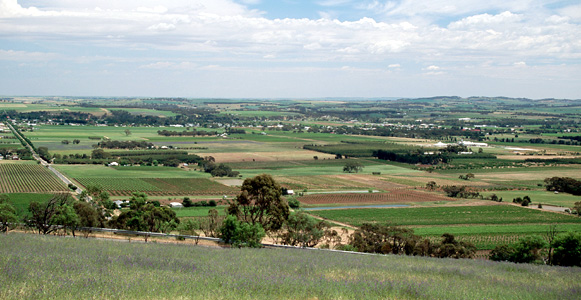
Service industries
The service industries, which include wholesale and retail trade, real estate and business services, and the hotel and restaurant industries are of increasing importance to the South Australian economy. Taken together, these areas employ about 70 percent of South Australia’s work force. Many service industries benefit from spending by tourists. Millions of tourists visit the state each year.
Transportation.
South Australia has a well-developed system of roads. The major railway lines provide an interstate service. Adelaide has an international airport. The state also has many smaller airports that provide regular public transportation.
South Australia has many commercial and privately owned ports. Port Adelaide is the state’s major port. The Outer Harbor of Port Adelaide handles passenger ships and also has facilities for handling cargo.
Government
South Australia’s government consists of the state Parliament and a representative of the British monarch, the governor. Voting is required in state and federal elections.
Parliament.
The South Australian Parliament has most of the governing power. It levies various taxes and receives funding from the national government. South Australia’s Parliament has two houses—the upper house, called the Legislative Council, and the lower house, called the House of Assembly.
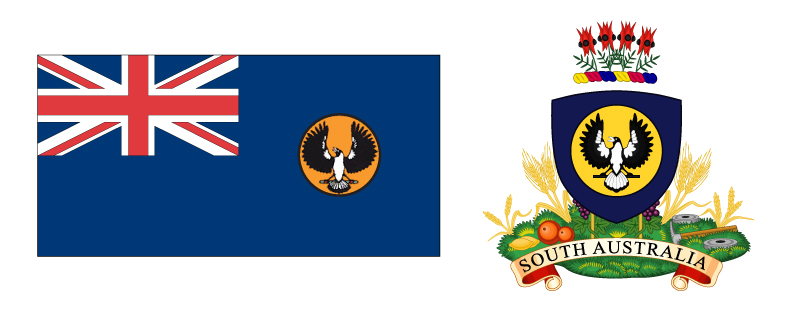
The Legislative Council has 22 members. There are no individual electoral districts for the Legislative Council in South Australia. Members of the Legislative Council are elected for a minimum term of eight years.
The House of Assembly has 47 members, elected from 47 electoral divisions for four years. The party with the most members in the House of Assembly forms the state government, if necessary in coalition (political alliance) with other, smaller parties. The leader of the main party becomes the premier. He or she chooses ministers for the Cabinet from among elected members of the majority party or coalition of parties in Parliament. The Cabinet is the central decision-making body of the government.
Local government
is the responsibility of South Australia’s district, town, and city councils. Council activities include waste management, local environmental management, local roads, town planning, parks, libraries, social planning, and many services. Voting is not compulsory (required) in local elections.
History
Aboriginal peoples
were the first inhabitants of South Australia. Warratyi is an archaeological site in the Flinders Ranges in the southeastern part of the state. Archaeologists (scientists who study the cultural remains left behind by past civilizations) have unearthed ancient tools and other evidence indicating that Aboriginal people lived there about 49,000 years ago.
The Aboriginal peoples who lived in what is now South Australia when Europeans first arrived belonged to about four dozen tribal groups. They spoke a variety of languages, had different cultural practices, and used a variety of techniques to manage land and water resources. For example, using a method called firestick farming (controlled burning of sections of land), the people cleared undergrowth in order to make travel and hunting easier and encourage plant diversity. Some groups constructed systems of weirs (wooden dams) and nets in the coastal wetlands in order to trap fish.
European exploration.
Dutch navigators made the first recorded European visits to Australia, in the early 1600’s. Their ships explored and charted every coastline except the eastern seaboard. In 1627, Dutch explorers on the ship Gulden Seepaert (Golden Seahorse) mapped the southern coast of the Australian continent from the southwestern tip of Western Australia along the Great Australian Bight to the Eyre Peninsula in South Australia. They covered a distance of more than 900 miles (1,450 kilometers).
The British navigator Matthew Flinders charted South Australia’s coastline in the Investigator in 1802. During his journey, Flinders met the French navigator Nicolas Baudin, who was also charting the coastline.
In 1828, the British government sent the British Army captain and explorer Collet Barker to explore the area further. Barker explored the east side of Gulf St. Vincent and named the Sturt River. He died in 1831 while trying to chart a passage from the Murray River to the sea.
The British military officer and navigator Charles Sturt traveled through the interior of the state during his explorations of the Murray River in 1830. Sturt sailed down the Murrumbidgee River into the Murray River and then followed the Murray to the sea, near what is now Adelaide. He opened the way for the establishment of the colony of South Australia in 1836.
Colonization.
Before the official colonization of South Australia began in the 1830’s, British whalers established whaling stations along the coast of South Australia. Sealers from the United States and the United Kingdom settled on Kangaroo Island.
In the early years of settlement, the colonial government granted land to deserving men and women in return for a small fee. The government hoped that this would encourage and reward responsible settlers as well as foster agriculture. During the 1820’s, Edward Gibbon Wakefield, a British colonial reformer, argued that the British government should sell Australian land at a higher cost and use the proceeds to assist immigrants in coming to the colony. He argued that the government should carefully choose prospective immigrants according to their skills. The price of land would control the number of settlers able to buy land. Wakefield called his plan systematic colonization.
In 1834, the British Parliament passed the South Australian Act, which followed Wakefield’s plan for assisted immigration. In 1836, a London banker and shipowner named George Fife Angas set up the South Australian Company and purchased a large tract of land to sell to potential settlers. It raised enough money to cover the costs of running the colony. The colony was founded under a joint agreement between the South Australian Company and the British government. They agreed that South Australia would be a British colony with a British governor, but the South Australian Company would appoint a board of commissioners to administer the sale of land.
In August 1836, William Light landed at Nepean Bay. In November, he traveled to Holdfast Bay (now Glenelg) and chose a site about 6 miles (10 kilometers) inland as the capital. On Dec. 28, 1836, John Hindmarsh took an oath to become the first governor of the colony and read a proclamation announcing the establishment of South Australia as a British colony. Light began planning Adelaide, the new capital, in 1837. 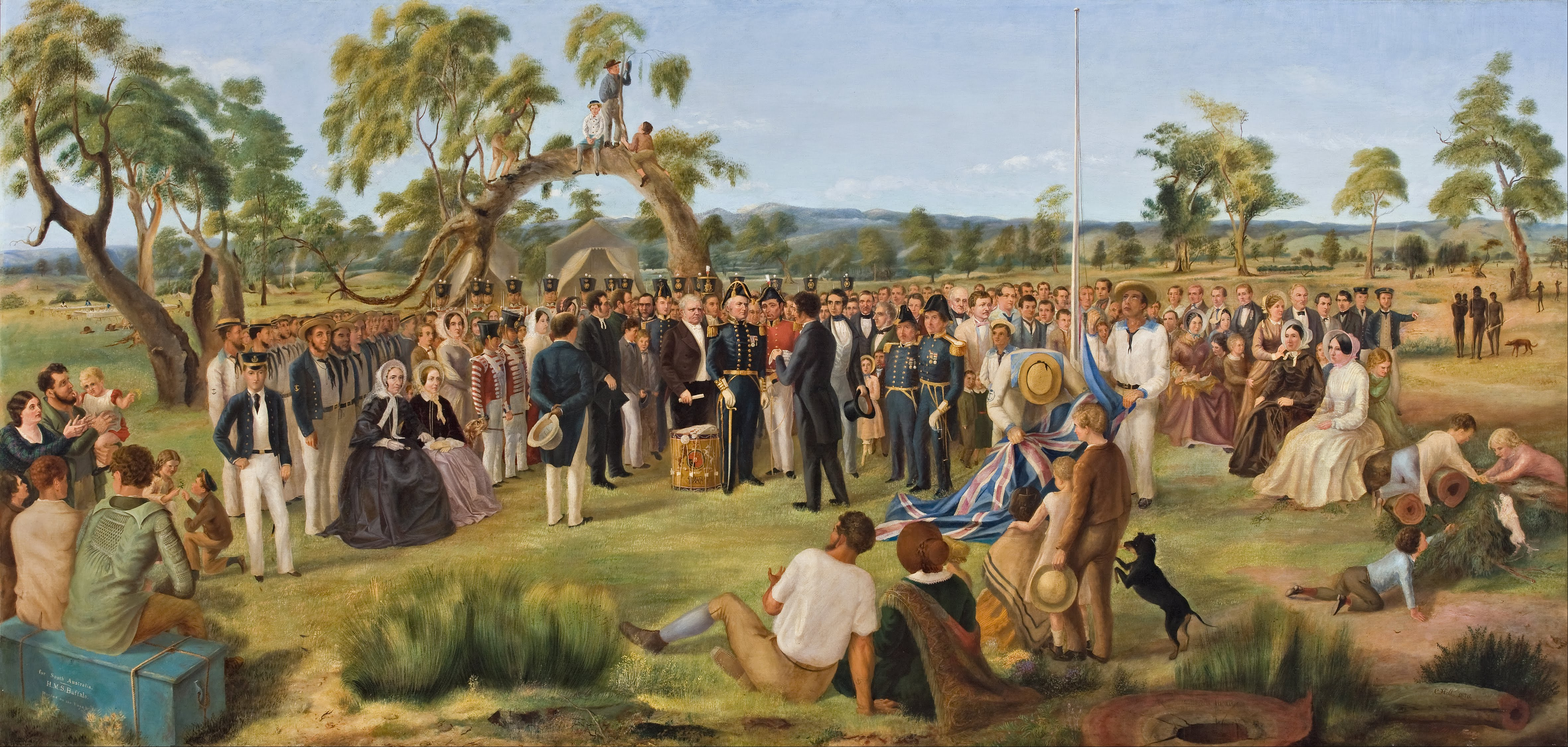
The colony was slow to develop. In 1841, the colony faced bankruptcy, and so the British government took over control of South Australia. Officials got rid of the controlling board of commissioners and made the governor the sole administrator of the colony. In 1842, the government created a Legislative Council for the colony. The colony’s new governor, Sir George Grey, introduced strict economic measures, and the colony’s economy began to improve. The discovery of copper at Kapunda and Burra in the 1840’s further boosted the colony’s economy. Large-scale immigration followed. Many of the immigrants settled in the Barossa Valley and helped establish South Australia’s wine industry.
Self-government.
In 1851, the British government allowed the colony to have its own constitution. South Australia became fully self-governing on Oct. 24, 1856.
In 1863, South Australia took over administration from New South Wales of the land that now makes up the Northern Territory. In 1870, workers began building the Overland Telegraph line between Adelaide and Palmerston (now Darwin) in the Northern Territory. This north-south transcontinental telegraph was completed in 1872. In 1895, South Australia became the first Australian colony to give women the right to vote. In 1911, the new federal government took over the administration of the Northern Territory.
Later development.
By 1938, South Australia had become a major center for Australia’s automobile industry. During World War II (1939-1945), the Leigh Creek coal field and Whyalla shipyards came into production. Engineers constructed a new reservoir and pipeline from the Murray River to provide water for the state’s growing cities and towns.
In the 1950’s, the city of Elizabeth was built north of Adelaide to provide housing for the growing population. In the early 1960’s, the population of the state passed 1 million. Wool and wheat were still the state’s major exports. But the value of industrial production, particularly motor vehicles and household appliances, had grown to exceed the value of agricultural production.
Immigration, mainly from the United Kingdom, rapidly increased the state’s work force. Many immigrants also arrived from southern Europe and, later, from Asia. Automobile manufacturers built new plants in Adelaide’s outer suburbs, and automobile component industries in the city. However, the Whyalla shipyards closed because of a lack of orders.
Following the discovery of natural gas in the state’s far north in 1963, a pipeline was constructed from Moomba to Adelaide. It came into operation in 1969. Additional gas discoveries were made in the Cooper Basin in the 1970’s. Vast quantities of copper, gold, and uranium were found at Roxby Downs.
In 1950’s, the British government carried out nuclear testing at Maralinga, an area north of Nullarbor Plain that was populated mainly by Aboriginal people. In 1984, the Australian government established a Royal Commission to investigate the health effects of the testing and disposal of the radioactive substances on the areas population. The commission found that the testing had serious, harmful effects on the local population. In 1985, the British government apologized and awarded compensation payments to those people who had suffered from the testing. The British government also agreed to pay for part of the costs of cleaning the site.
In 1984, South Australia’s Parliament passed the Maralinga Tjarutja Land Rights Act. Under this act, the state returned about 29,300 square miles (76,000 square kilometers) of land in the north of the state to its traditional Aboriginal owners.
In late 1999, the outback town of Woomera became the site of a detention center for illegal immigrants. Riots and fires by inmates over conditions in the center erupted in the early 2000’s. The government closed the center in 2003.
The final section of a transcontinental railroad stretching from Adelaide to Darwin was completed in 2003 and went into operation in 2004. The production of renewable energy has expanded significantly in South Australia during the 2000’s. Wind farms provide a significant portion of the state’s electricity. Other forms of technology, including medical technology, are also growing industries in the state.
In late 2019, intense drought conditions and high temperatures led to an outbreak of bushfires across Australia. The fires continued into early 2020. In South Australia, dozens of fires raged, burning hundreds of thousands of acres of land, destroying many buildings, and causing the deaths of several people. On Kangaroo Island, the fires affected about half the island. Early 2020 also brought the health care and economic challenges of the COVID-19 pandemic to South Australia, as it did to other regions of Australia and the world.
